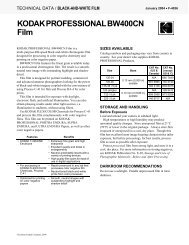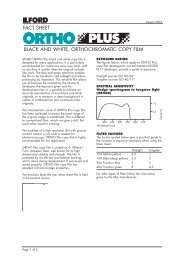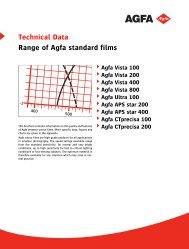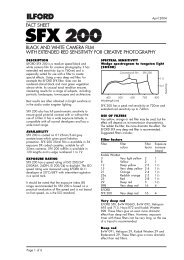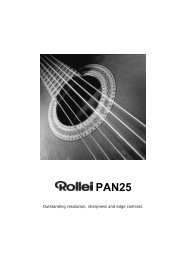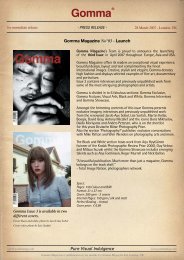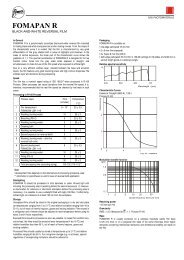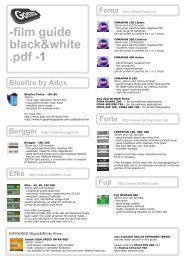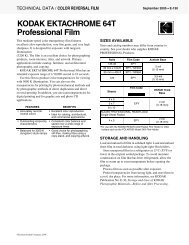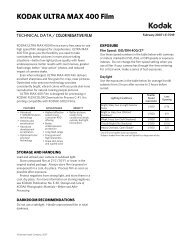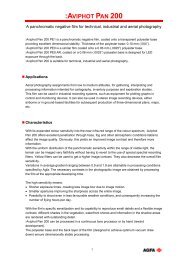PORTRA Film Q&A - Gomma
PORTRA Film Q&A - Gomma
PORTRA Film Q&A - Gomma
You also want an ePaper? Increase the reach of your titles
YUMPU automatically turns print PDFs into web optimized ePapers that Google loves.
QUESTIONS & ANSWERS<br />
What's new with KODAK PROFESSIONAL <strong>PORTRA</strong> <strong>Film</strong>?<br />
2006 was a great year for Professional Photographers. KODAK PROFESSIONAL <strong>PORTRA</strong> 800 <strong>Film</strong> was improved in the first quarter<br />
and now a new generation of KODAK PROFESSIONAL <strong>PORTRA</strong> 160- and 400-speed <strong>Film</strong>s have been reengineered to deliver<br />
significantly finer grain while maintaining superb skin tone reproduction.<br />
All the new films feature the following technical advancements:<br />
• New Micro-Structure Optimised T-GRAIN Emulsion<br />
Significant improvements in KODAK T-GRAIN® Emulsion technology combined with the use of advanced development accelerators<br />
and antenna dye spectral sensitisation, provide reduced granularity for smoother optical prints and enhanced scanning performance<br />
while maintaining the true-to-speed rating of <strong>PORTRA</strong> <strong>Film</strong>s.<br />
• Advanced Development Accelerators<br />
These proprietary compounds increase the speed of Kodak's silver-halide emulsions without adding grain or degrading image<br />
sharpness. They allow the latent image site on the exposed silver-halide grains to be more easily detected during the development<br />
process, resulting in better overall imaging efficiency.<br />
• Antenna Dye Sensitisation (400 and 800 speed)<br />
Silver-halide crystals have an inherent sensitivity to blue and ultraviolet light. They are made sensitive to other wavelengths of light<br />
by adding organic dyes, which adsorb to the surface of the crystals. Antenna dye sensitisation binds a second layer of dye to the<br />
original sensitising dye layer. The energy absorbed in the outer layer is efficiently transferred to the dye at the surface of the silver<br />
halide. This enhanced light absorption increases the photographic sensitivity of the crystals, resulting in improved overall imaging<br />
efficiency in <strong>PORTRA</strong> 400- and 800-speed <strong>Film</strong>s.<br />
What are the benefits of this new generation of <strong>PORTRA</strong> <strong>Film</strong>s?<br />
For years, professional photographers have preferred KODAK PROFESSIONAL <strong>PORTRA</strong> <strong>Film</strong>s for their consistently smooth, natural<br />
reproduction of the full range of skin tones. Thanks to the aforementioned technical advancements, <strong>PORTRA</strong> <strong>Film</strong>s now deliver even<br />
finer grain at all speeds for improved scanning performance and greater enlargement capability.<br />
Are there any differences in contrast and saturation compared to the current <strong>PORTRA</strong> 160- and 400-speed <strong>Film</strong>s?<br />
<strong>PORTRA</strong> 160NC and <strong>PORTRA</strong> 400NC <strong>Film</strong>s have the same contrast and colour saturation as the previous generation.<br />
The contrast of the new <strong>PORTRA</strong> 160VC and <strong>PORTRA</strong> 400VC <strong>Film</strong>s has been lowered and the colour saturation has been increased<br />
(via interlayer interimage effects). The result is a more ideal combination of these two features, for optimal performance in<br />
applications where enhanced colour saturation is desired.<br />
Why did you improve <strong>PORTRA</strong> <strong>Film</strong>s?<br />
We’ve said that we will support both digital and film users. <strong>Film</strong> is our<br />
heritage, and there are many photographers, particularly professional<br />
photographers, who still prefer to work with film, shooting either<br />
exclusively with film or in addition to digital capture. <strong>Film</strong> users represent<br />
a market we will continue to serve, and these new <strong>PORTRA</strong> <strong>Film</strong>s<br />
demonstrate our commitment to providing professional photographers<br />
with the very best tools available.<br />
How can I tell if I have the newest generation of<br />
<strong>PORTRA</strong> 160- and 400-speed <strong>Film</strong>s?<br />
• New packaging materials (cartons will have a callout)<br />
• The 120/220 foil hot stamp makes it easy to identify the<br />
new film - example:<br />
Imaging Solutions
QUESTIONS & ANSWERS<br />
How can I tell if I have the newest generation of film? (Continued)<br />
• The edgeprints of the new films will be updated as follows:<br />
Current <strong>PORTRA</strong> <strong>Film</strong> Edgeprint:<br />
New Edgeprint:<br />
• • KODAK 160NC • • KODAK 160NC-2<br />
• • KODAK 160VC • • KODAK 160VC-2<br />
KODAK 400NC <br />
KODAK 400VC <br />
KODAK 400NC-2<br />
KODAK 400VC-2<br />
When will the new 160- and 400-speed film be available?<br />
New generation <strong>PORTRA</strong> <strong>Film</strong>s will be available worldwide on a stock-turnover basis beginning in Q4 2006.<br />
Will CAT Numbers change?<br />
No.<br />
What sizes?<br />
• <strong>PORTRA</strong> 160NC, 400NC, and 400VC <strong>Film</strong>s are available in 35 mm, 120, 220, and sheet sizes.<br />
• <strong>PORTRA</strong> 160VC <strong>Film</strong> is available in 35 mm, 120, 220, and sheet sizes. Also in KODAK PROFESSIONAL READYLOAD Packets.<br />
• <strong>PORTRA</strong> 800 <strong>Film</strong> is available in 35 mm, 120, and 220 sizes.<br />
Do I need to do anything different to print or scan these new <strong>PORTRA</strong> <strong>Film</strong>s?<br />
No. The new films are designed to be printing and scanning compatible with the existing family of <strong>PORTRA</strong> <strong>Film</strong>s.<br />
What will happen to KODAK PROFESSIONAL <strong>PORTRA</strong> 100T <strong>Film</strong>?<br />
Due to declining volumes, KODAK PROFESSIONAL <strong>PORTRA</strong> 100T <strong>Film</strong> will be dropped from the portfolio by year-end 2006 as<br />
supplies run out. For applications requiring tungsten balance, we suggest using one of the other <strong>PORTRA</strong> <strong>Film</strong>s with appropriate<br />
filtration. Please refer to the following table:<br />
Light Source<br />
KODAK<br />
WRATTEN<br />
Gelatin<br />
Filter[a]<br />
160NC and<br />
160VC <strong>Film</strong>s<br />
EI Speed<br />
400NC and<br />
400VC <strong>Film</strong>s<br />
800 <strong>Film</strong><br />
Photolamp<br />
(3400 K)<br />
Tungsten<br />
(3200 K)<br />
No. 80B 50 125 250<br />
No. 80A 40 100 200<br />
[a] For best results without special printing.<br />
©Eastman Kodak Company, 2006<br />
Kodak, Kodak Professional, Portra, Readyload, Wratten, and T-Grain<br />
are trademarks of Eastman Kodak Company.




